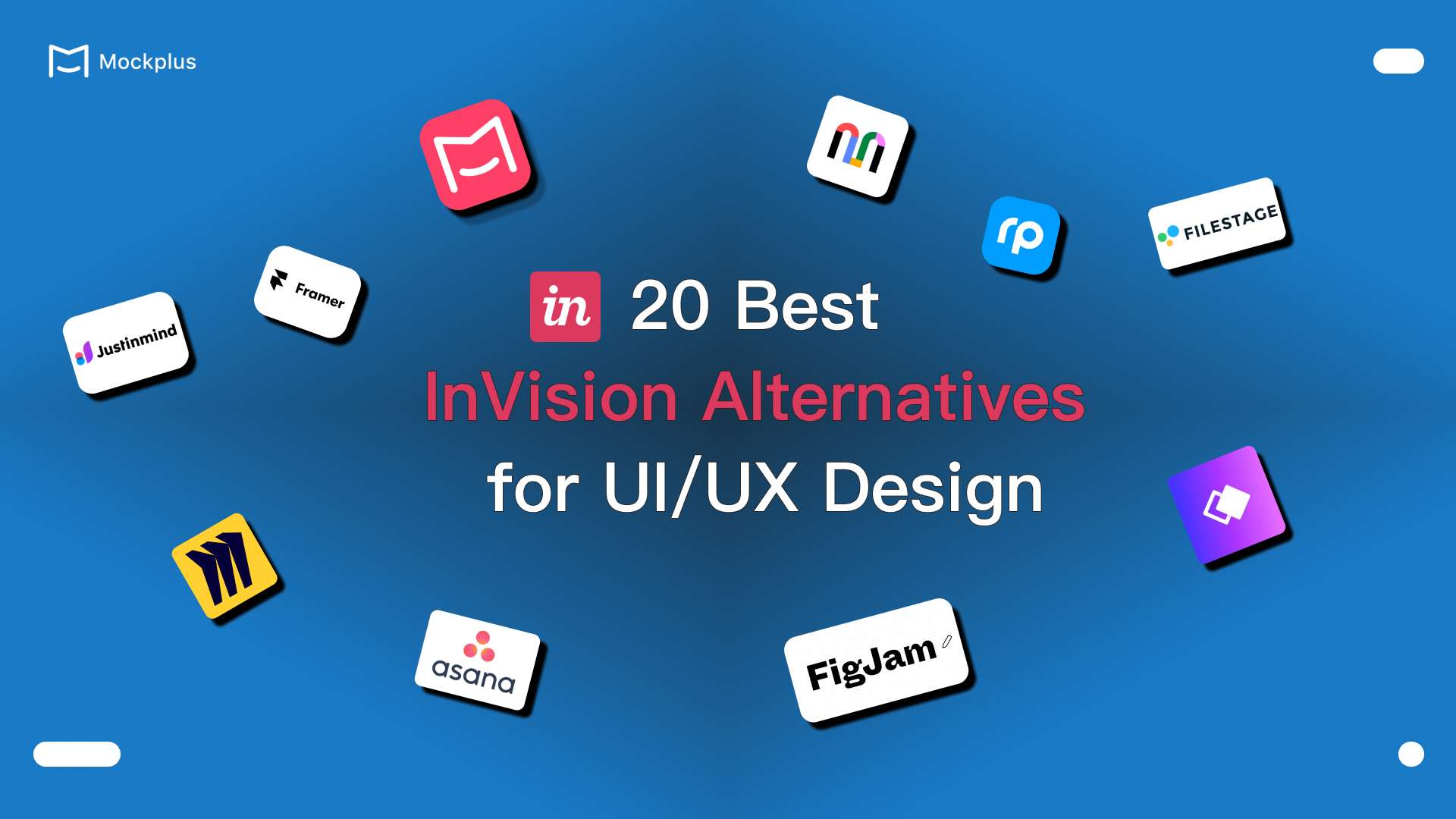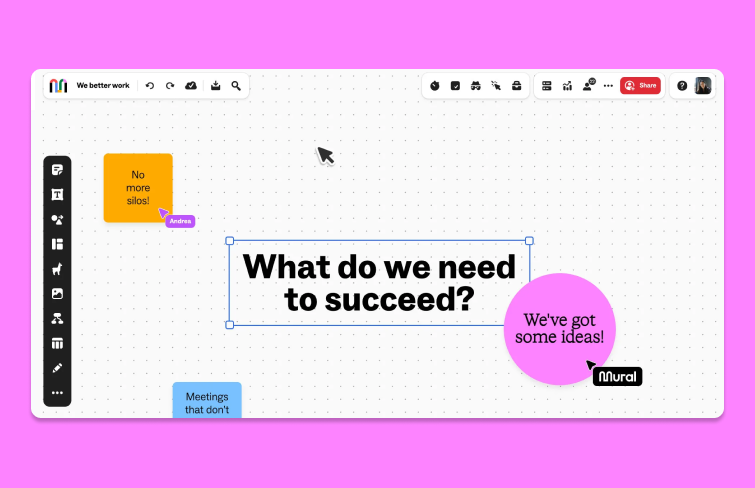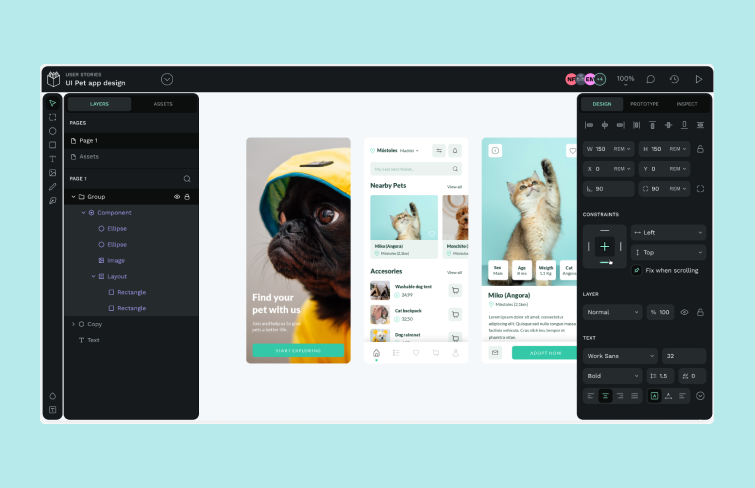
InVision has long been a leading platform for UI/UX designers, offering tools for collaboration, prototyping, and gathering feedback on design projects. However, it already announced its discontinution of design collaboration services (including prototypes, DSM, etc) at the end of 2024. Moreover, as technology evolves and user needs change, alternatives to InVision have emerged, each offering unique features and advantages.
In the article, we'll explores 20 of the best InVision alternatives, highlighting their key features, pros & cons, helping you evaluate which platform best suits your design needs. Let's dive in!
Founded in 2011, InVision is a widely-used product design and collaboration tool that empowers teams to prototype, design, and refine digital products. Built for design teams, it facilitates collaboration across all stages of the design process, from prototyping to design handoff.
Its key feature, Freehand, serves as a digital whiteboard, enabling real-time brainstorming and feedback sharing among remote teams. Additionally, InVision Studio offers a more advanced desktop solution for creating detailed prototypes, while InVision DSM helps maintain design consistency through design systems. Overall, InVision provides a unified platform to manage the entire design lifecycle, enhancing creativity and collaboration across teams.

InVision stands out in the UI/UX design space with its all-encompassing suite of features, which cater to collaboration, prototyping, testing, and design handoff. The platform’s seamless collaboration tools facilitate real-time feedback through commenting and sharing, making it easy for team members, clients, and stakeholders to stay aligned throughout the design process. This ensures faster decision-making and reduces miscommunication.
Additionally, InVision’s design handoff tools simplify the transition from design to development, enabling designers to easily share assets, specifications, and code snippets. This streamlines workflows and minimizes the risk of errors during development. Scalable for teams of all sizes, InVision provides a cloud-based solution that makes design collaboration accessible from anywhere.
Despite its initial success, InVision has faced significant performance issues that hindered its ability to create prototypes with smooth animations. These performance concerns became so detrimental that the platform's features, even the ones that initially set it apart, became largely ineffective.
Additionally, InVision excels in prototyping and collaboration, but it falls short in providing comprehensive design capabilities. As a result, users often need to turn to other tools to handle the core design tasks, limiting its use as an all-in-one solution.
Last but not the least, as InVision winds down its services at the end of 2024, the future remains uncertain. Freehand, its visual collaboration tool, was acquired by Miro, and the company has yet to announce new projects. With InVision's imminent shutdown, it’s no surprise that many are seeking alternatives that offer more robust features, better performance, and greater reliability for the long term.
Choosing the right alternative for InVision involves considering a variety of factors.
Below are some key aspects to take into account:
When choosing an InVision alternative, ease of use is one of the most important factors to consider. A tool that is intuitive and user-friendly helps reduce the learning curve, allowing designers to focus on their work rather than spending time on training. Platforms that offer a simple, clean interface and easily accessible features improve overall productivity and user satisfaction.
Collaboration is central to successful design workflows, especially for teams working remotely or across different time zones. When selecting an alternative to InVision, consider tools that offer real-time collaboration features, such as live editing, comment threads, and instant feedback. It help streamline communication between designers, developers, and stakeholders, ensuring that everyone is aligned on the same page.
For a design tool to seamlessly fit into an existing workflow, it must integrate well with other tools commonly used by design and development teams. The more integration a tool supports, the easier it is to synchronize workflows across different teams. For example, Mockplus Cloud supports importing design files from Figma, Sketch, Adobe XD, and Photoshop. It also integrates with tools like Trello and Jira, enabling a seamless workflow. This robust integration capability allows it to quickly adapt to various team needs.
Cost-effectiveness is a critical consideration when selecting an InVision alternative. It's important to balance the features offered with the pricing structure to ensure that you're getting value for your investment.
Mockplus Cloud is a web-based design collaboration and handoff platform. It stands out as the top-rated InVision alternative, offering everything you need and love in InVision. With all the essential features for prototyping, UI/UX design collaboration, dev handoff, and design systems, Mockplus enables your team to work seamlessly without disruption.
Additionally, Mockplus Cloud provides way more features than InVision, including online PRD, sticky notes, comments & annotations, cutomizable task management and more ,ensuring clear communication and collaboration throughout the entire product design lifecycle.
Moreover, Mockplus is also more cost-effective than InVision, offering design collaboration and handoff for teams at just $4.95 per user per month, significantly lower than InVision's $7.95 per user per month.
In conclusion, Mockplus Cloud is a more powerful and cost-effective collaboration platform compared to InVision.
Key Features
Pros:
Cons:
Pricing

Mural is a digital workspace designed for visual collaboration, enabling teams to brainstorm, plan, and design together remotely. With interactive whiteboards, sticky notes, and diagrams, Mural supports a variety of workflows, including project planning, design thinking, and agile methodologies.
Key Features
Pros:
Cons:
Pricing
Mural offers a free plan with limited features, with paid plans starting at $12 per user/month

Miro is a popular collaborative whiteboarding platform that facilitates brainstorming, visual collaboration, and team ideation. After acquiring Freehand in 2023, Miro enhanced its capabilities by incorporating Freehand’s visual collaboration features, providing a powerful tool for remote and hybrid teams.
Key Features
Pros & Cons
Pros:
Miro offers a wide range of tools ideal for diverse use cases and offers a wide range of templates to kickstart.
Cons:
It can be overwhelming for beginners and performance may lag with large boards.
Pricing

Zeplin is a collaborative workspace tool designed to bridge the gap between design and development. It serves as a platform for documenting designs, explaining how they should behave, and providing a centralized space for teams to collaborate. Zeplin enables teams to stay aligned throughout the product development cycle, ensuring smooth transitions from design to development.
Key Features
Pros & Cons
Pros:
Zeplin simplifies design handoffs by providing clear documentation and real-time collaboration, ensuring design and development teams stay aligned.
Cons:
Zeplin focuses on collaboration between design and development teams, which may not suit teams needing advanced design features or prototyping capabilities.
Pricing
Zeplin offers a free plan with basic features, while paid plans start at $12 per month.

Asana is a widely-used project management tool designed to help teams organize and track their work. With customizable views and task management features, it provides a centralized hub for planning, collaboration, and monitoring design projects and tasks.
Key Features
Pros:
Cons:
The interface can be overwhelming for new users, and the free plan has very limited features.

Filestage is a design approval platform that simplifies the review and feedback process for creative teams. Ideal for managing design workflows and centralizing discussions on design files, it streamlines the approval process and ensures efficient collaboration between teams and stakeholders.
Key Features
Pros:
Cons:
Pricing

Whimsical is a versatile visual collaboration platform designed to enhance productivity for small businesses. It enables teams to brainstorm, create mind maps, and share notes in a unified space. Ideal for project management, design research, and strategy mapping, it integrates AI-powered suggestions to streamline workflows and boost creativity.
Key Features
Pros:
Cons:
Pricing

Quant-UX is an open-source design platform tailored for UX design, research, and prototyping. It allows designers to create interactive prototypes with functional components, animations, and clickable links, and provides robust user testing features such as A/B testing, screen recording, and questionnaires.
Key Features:
Pros:
Cons:
Pricing

Penpot is an open-source UI and UX design tool focused on collaborative design with built-in CSS and SVG support, aimed at bridging the gap between design and development teams. It offers flexible, responsive design capabilities and is fully accessible for free, with additional paid options for premium support and enterprise features.
Key Features:
Pros:
Cons:
Pricing

Lucidspark is a whiteboard collaboration tool designed to facilitate brainstorming, project planning, and team ideation. With its unique Breakout Boards feature, Lucidspark allows teams to split large projects into smaller, focused sessions, making it ideal for agile teams working across various skill sets.
Key Features
Pros:
Cons:
Pricing
Lucidspark offers a free plan with up to three project boards, with paid plans starting at $7.95 per month (billed annually).

Marvel is a lightweight yet powerful UX and UI design tool that excels in simplicity and speed, making it a popular alternative to Sketch. Designed with rapid prototyping in mind, Marvel allows designers to quickly transform ideas into interactive mockups, making it an ideal tool for collaboration with stakeholders, especially during the early stages of a project.
Key Features:
Pros:
Marvel's user-friendliness makes it accessible to designers at all levels, from beginners to professionals. Its built-in testing tools allow for early validation of concepts, and the handoff features make it easy for developers to implement designs with all necessary assets.
Cons:
Pricing

Mockplus RP is a powerful InVision alternative that offers an intuitive, budget-friendly online platform for creating, prototyping, testing, and iterating web or app ideas. With its easy-to-use interface, Mockplus RP allows you to transform sketches, wireframes, and diagrams into realistic, interactive prototypes quickly—ideal for teams seeking to test and refine design concepts early in the process.
Key Features
Pros:
Cons:
Pricing

UXPin is a robust InVision alternative that excels in creating highly interactive and realistic prototypes, making it ideal for teams requiring advanced prototyping capabilities. With its code-based approach, UXPin offers precise control over the design process, allowing for complex interactions and seamless collaboration within teams. Its integration with design systems ensures consistency and efficiency across projects.
Key Features
Pros:
Cons:
Pricing

ProofHub is a fast and efficient InVision alternative, designed to help teams collaborate on designs with ease. Its intuitive interface allows designers to quickly share feedback, work with clients and teammates, and streamline project management tasks, making it an excellent tool for both design collaboration and task organization.
Key Features
Pros:
Cons:
Pricing

Framer is a standout InVision alternative that blends design and coding, offering a powerful platform for teams needing highly interactive prototypes with custom animations. With its ability to integrate real code into designs, Framer bridges the gap between design and development, making it an excellent choice for projects that require detailed, lifelike prototypes.
Key Features
Pros:
Cons:
Pricing

Justinmind is a powerful prototyping tool that allows teams to create interactive, data-driven prototypes with advanced features like gestures, data binding, and simulations. It's an ideal solution for both simple mobile apps and complex enterprise software, offering seamless integration with design and development tools.
Key Features
Pros:
Cons:
Pricing
Justinmind offers a free plan with basic features, while paid plans start at $9 per user/month.

Flinto is a powerful prototyping tool designed for creating high-fidelity, animated prototypes. Known for its rich feature set, it’s a popular choice among designers for wireframing and prototyping, especially when intricate animations and transitions are required. Flinto’s user-friendly interface and advanced tools allow designers to bring their ideas to life without the need for coding.
Key Features
Pros:
Cons:
Pricing

FigJam is a collaborative whiteboarding tool created by Figma, designed for teams to brainstorm, map user journeys, and visualize workflows. If you’re already using Figma for UI design, FigJam integrates seamlessly into your workflow, making it a great option for user journey mapping and collaborative planning.
Key Features
Pros:
Cons:
FigJam may be less suitable for complex diagramming needs compared to specialized tools.
Pricing

Siter.io is a powerful no-code website builder designed to simplify the creation of websites. It is an excellent choice for those looking for a no-code solution that streamlines the web design process. Its intuitive design tools and real-time collaboration features make it an ideal InVision alternative, enabling teams to collaborate and build websites quickly without the complexity of coding.
Key Features
Pros:
Cons:
Pricing

Webflow is a all-in-one responsive web design platform that offers an online visual editor for designing, building, and launching websites. It combines powerful design and development tools with a user-friendly interface, enabling seamless creation and collaboration on web projects. Its real-time collaboration features and robust integrations make it easy for teams to work together efficiently, while its extensive customization options provide flexibility for diverse project needs.
Key Features
Pros:
Cons:
Pricing

Overall, InVision has been a leading tool in the UI/UX design space for many years. However, with its services shutting down at the end of 2024, finding a powerful and reliable alternative has become essential. In this article, we’ve explored 20 top InVision alternatives for UI/UX design, each offering distinct features to meet the diverse needs of design teams. Whether you prioritize seamless collaboration or advanced design functionalities, these 20 options provide a comprehensive range of solutions to replace InVision and enhance your design workflow.
 Mockplus RP
Mockplus RP
A free prototyping tool to create wireframes or interactive prototypes in minutes.
 Mockplus DT
Mockplus DT
A free UI design tool to design, animate, collaborate and handoff right in the browser.
